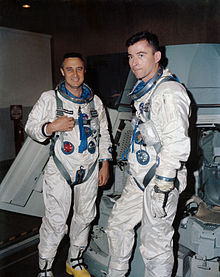Gemini 3

Astronauts John Young and Gus Grissom walk up the ramp leading to the elevator that will carry them to the spacecraft for the first manned Gemini mission
|
|
| Operator | NASA |
|---|---|
| COSPAR ID | 1965-024A |
| SATCAT № | 1301 |
| Mission duration | 4 hours, 52 minutes, 31 seconds |
| Distance travelled | 128,748 kilometers (80,000 mi) |
| Orbits completed | 3 |
| Spacecraft properties | |
| Spacecraft | Gemini SC3 |
| Manufacturer | McDonnell |
| Launch mass | 3,236.9 kilograms (7,136 lb) |
| Crew | |
| Crew size | 2 |
| Members |
Virgil I. "Gus" Grissom John W. Young |
| Callsign | Molly Brown |
| Start of mission | |
| Launch date | March 23, 1965, 14:24:00 UTC |
| Rocket | Titan II GLV, s/n 62-12558 |
| Launch site | Cape Kennedy LC-19 |
| End of mission | |
| Recovered by | USS Intrepid |
| Landing date | March 23, 1965, 19:16:31 UTC |
| Landing site | 22°26′N 70°51′W / 22.433°N 70.850°W |
| Orbital parameters | |
| Reference system | Geocentric |
| Regime | Low Earth orbit |
| Perigee | 161 kilometers (87 nmi) |
| Apogee | 225 kilometers (121 nmi) |
| Inclination | 32.6 degrees |
| Period | 88.35 minutes |
| Epoch | March 23, 1965 |
 (L-R) Grissom, Young |
|
Gemini 3 was the first manned mission in NASA's Gemini program, the second American manned space program. On March 23, 1965, astronauts Gus Grissom and John Young flew three low Earth orbits in their spacecraft, which they nicknamed Molly Brown. This was the ninth manned US spaceflight (including two X-15 flights over 100 kilometers), and the 17th world human spaceflight including eight Soviet flights. It was also the final manned flight controlled from Cape Kennedy Air Force Station in Florida, before mission control functions were shifted to a new control center located at the newly opened Manned Spacecraft Center in Houston, Texas.
(This was the prime crew on Gemini 6)
The crew of Gemini 3 was changed after Shepard was grounded with an inner ear disorder in late 1964.
The mission's primary goal was to test the new, maneuverable Gemini spacecraft. In space, the crew fired thrusters to change the shape of their orbit, shift their orbital plane slightly, and drop to a lower altitude. Other firsts were achieved on Gemini 3: two people flew aboard an American spacecraft (the Soviet Union launched a three-man crew on Voskhod 1 in 1964 and a two-man crew just a few days earlier on Voskhod 2, upstaging the two-man Gemini and three-man Apollo programs), and the first manned reentry where the spacecraft was able to produce lift to change its touchdown point.
On March 23, 1965 at 15:57:00 UTC, at the end of the first orbit, over Corpus Christi, Texas, a 1-minute 14 second burn of the Orbit Attitude and Maneuvering System (OAMS) engines gave a reverse delta-V of 15.5 meters (51 ft) per second, which changed the orbit from 161.2 by 224.2 kilometers (87.0 by 121.1 nautical miles) (with a period of 88.3 minutes), to an orbit of 158 by 169 kilometers (85 by 91 nmi) (period of 87.8 minutes). This was the first orbital maneuver made by any manned spacecraft.
...
Wikipedia

